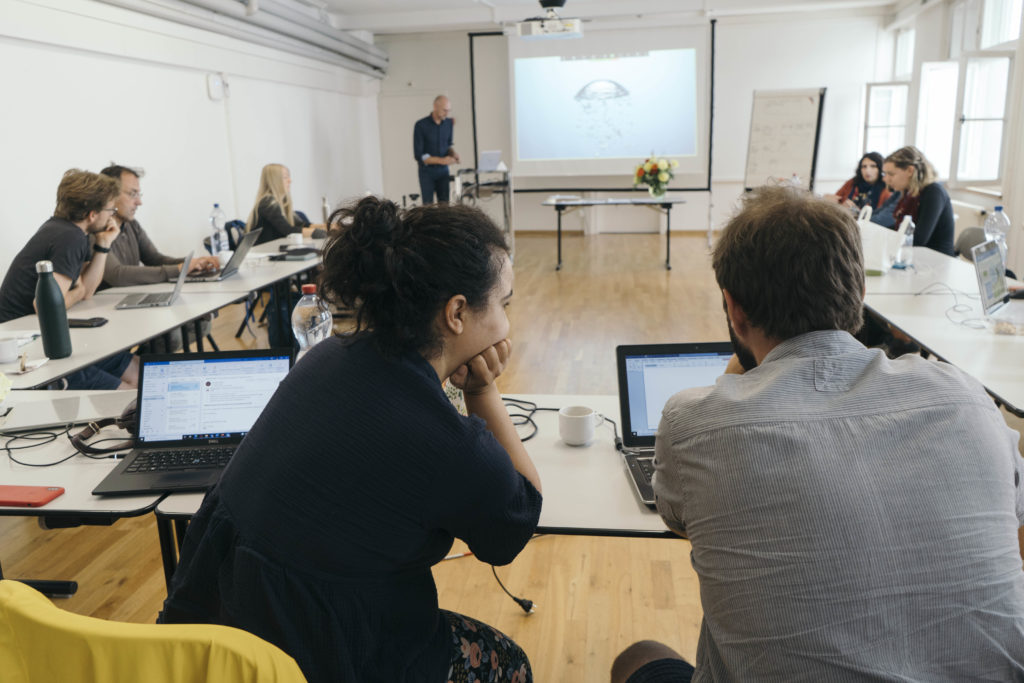From 14-16th September 2021, AGROMIX project held its 3rd workshop tackling systems design and synergies led by Daniël de Jöng from Wageningen University & Research – lead partner of AGROMIX work package 2 (WP2). The workshop was a three-day interactive meeting held at the institute of the Institute for Environment and Natural Resources in Wädenswil, Switzerland
The workshop brought together members of AGROMIX’s first six pilot projects - from six different countries - to establish a common participatory design methodology for each to test on their own site. Over 10 participants contributed to the design workshop including farmers, designers, researchers and communicators - each representing different project work packages, gathering to innovate and identify barriers and opportunities to drive a new participatory design approach for resilient land use in Europe.

AGROMIX’s WP2 on systems design and synergies is at the heart of the project, with the objective of using participatory design to develop tailor-made mixed farming and agroforestry systems for specific agro-climatic contexts across Europe; WP2’s methodology will be developed with the six pilot sites present at the workshop, and will be tested on six further sites in the project’s second phase. As well as the contribution of the pilot sites, the WP2 team will work closely with those of WP3, WP4 and WP5 to gather the data needed for modelling, developing innovative tools (the MIX-App), and identifying new market and financial possibilities.
The activities hosted over the three days included dynamic sessions for the pilot teams to exchange experiences, a curated carrousel that allowed joint learning through peer-to-peer communication, a field visit, a training session, and interviews with AGROMIX communications leader REVOLVE, identifying communication and dissemination opportunities from the pilot sites.
Participatory design
The three-day workshop explored the participatory design method which consists of identifying the needs of different stakeholders including farmers, processors, traders, sellers and wider society by bringing them together to consider the complex trade-offs, such as: income stability, resilience to climate change, and environmental impacts.
The event also provided an opportunity to learn more about the transition towards mixed farming and agroforestry systems by offering projections of the expected resilience and sustainability performance at the farm level for each pilot team, using a multi-criteria assessment tool (Task 4.1). Olivia Tavares from the Institut Technique de l'Agriculture Biologique (France) led a Multicriteria Assessment training providing tools to:
This assessment provides a multicriteria assessment at the individual pilot level based on three dimensions: social, economic, and environmental. AGROMIX’s vision is for the pilot sites to be representative of a variety of farms across Europe, thus providing inspiration for land managers across the continent to increase their resilience and sustainability performances.

Field Visit
The workshop was hosted by Mareike Jäger from the Zurich University of Applied Sciences (ZHAW) and Sonja Kay from Agroscope who coordinate one of the co-design pilot sites within AGROMIX. This pilot site is a national agroforestry network, where they implement various goals within the framework of a design process.

The Swiss Agroforst Network team organised a field trip to meet the farmer Simon Küng and get to know his innovative field work on diverse agroforestry systems and techniques such as forestfarming, intercropping systems, silvopastoral systems, and animal husbandry. Küng’s 32ha farm is located in the centre of Switzerland on 740masl, with 1200mm precipitation per year.
In an interview with REVOLVE, Küng explained: “Our main branch of farming is suckler cow husbandry. We have 50 mother cows and 300 fattening pigs, so meat is still the main output of our business. However, I have also taken over 180 high-stem trees of various varieties, especially apple. In recent years I have built up an agroforestry system using nut trees, and I’m convinced that this is a seminal production system because the versatility of trees in combination with other elements contribute to the stability of nature. When these systems are managed properly stability is promoted and output is high.’’

The way forward
This first on-site workshop provided a platform to exchange ideas and brainstorm new ways to drive the transition towards resilient and efficient land use in Europe. Due to the unique social, environmental and economic conditions present across Europe, it is difficult to directly replicate mixed farming and agroforestry systems from one location to another. Therefore, to achieve the widespread implementation of mixed farming and agroforestry systems we need to design new agricultural systems and further develop existing systems.
As Zaira Ambu from IfaS stated: “The co-design is definitely something that will help us to reinvent food systems and to reach new people, to involve many more stakeholders that are not yet in this first vision of what we are doing. I envision a multi-production system on the same land that integrates different elements and that considers biodiversity as a need, and not as an obstacle.”